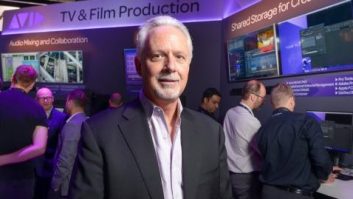Since 1996, when the UN General Assembly declared November 21st as World Television Day to mark the impact the TV had in our decision-making, the concept of television has changed drastically.
Today, although it still plays an important role in our lives, the television is no longer synonymous with a box with a screen for families to gather around. From OTT platforms to linear FAST channels, mobile devices to traditional TV sets, online to 5G to AI, when we say we’re watching TV it can mean many different things. Industry executives review the events of the past year which proved that the TV can still catch the attention of masses – from the Queen’s funeral to the war in Ukraine – while analysing the trends that are reshaping how we produce, distribute and watch these events.
Content creation tools to catch up with demand
From local meetings to national news, the world’s consumption of video continues to grow, driven by our ability to access and view content on any platform, across any device, and at any time.
“Yet creating dynamic video content remains complex – with the tools required designed for broadcasters’ or those with professional training,” observes Graham Sharp, CEO, Broadcast Pix. “At a time when everyone wants to create professional-looking video, we need to provide easier ways for their stories to be created.”
He says integrated tools and hybrid workflow capabilities provide a better production experience, while touchscreens and smart devices increase flexibility of location and improve operator control.
“User-friendly interfaces simplify control and make content creation more accessible for more people. This World Television Day, let’s celebrate by thanking all of our content producers, from community volunteers, to student broadcasters and industry veterans.”
Shared experience through broadcast
Atomos, which makes monitor recorders, says it remains dedicated to making production technology accessible to as many video content creators as possible. “It remains profoundly moving to experience large social moments through conventional broadcasts, to have that sense of a collective consciousness and a feeling that the entire world is watching with you,” says Trevor Elbourne, CEO.
“At the same time, we also celebrate the ways technological innovations, whether that be connected devices or cloud-based services, are breaking down the traditional barriers to entry.”
But despite the inexorable shift of distribution from satellite/cable to the internet it is still linear TV and the main box in the living room around which we cluster for the biggest global events.
“2022 has seen its fair share of such moments, and at these pivotal times it is the linear channels which form the heart of any broadcaster’s multi-platform coverage, helping to inform the national and international debate and uniting audiences around key experiences,” states Alison Pavitt, director of sales and marketing, Pebble.
If there’s something that the past year and the recent pandemic have highlighted, it is the increasing importance of preserving this history through the archiving and digitisation of important assets, to respond to a growing demand for available content.
“Television continues to hold and document an important part of our history as a society,” adds Simon Jones, studio manager for UK, Iron Mountain Entertainment Services.
Even as OTT platforms supplement productions with the digitisation of existing analogue content, the need for proper asset storage grows. Jones points out that sports rights holders have benefited from the digitisation of broadcasts. One project overseen by Iron Mountain Entertainment Services saw almost 7,000 hours of Premier League football content digitised. “These massive undertakings will enable viewers to rewatch iconic matches for many years to come, preserving these moments in sports history,” he adds.
Mobile TV takes centre stage
Although television “still plays an essential role in our lives, it is no longer the foundation for content distribution and consumption,” believes Williams Tovar, 5G media streaming solutions director, Ateme.
“Today, 5G makes it possible to deliver content everywhere, while optimising resources and having even greater impact thanks to immersive and interactive experiences,” he continues. “In addition, 5G has the potential to play an increasingly important role in sustainable video streaming [which now represents up to 69 per cent of global mobile data traffic, according to the Ericsson Mobility Report 2022].”
By adapting deployed resources to actual consumption, Tovar thinks sustainable TV streaming delivered over 5G networks “can contribute to reducing the environmental impact of our ever-growing demand for entertainment content.”
Combating fake news a priority
Television does however continue to play a central role in reporting and influencing major domestic and global issues. This includes key challenges such as combating misinformation.
“Recent turbulent events have put news producers under renewed pressure to manage profound technological and logistical obstacles,” explains Michael Pfitzner, VP Newsroom Solution, CGI
The growth of ‘fake news’ has heightened scrutiny for broadcasters focused on delivering accurate and credible reporting and analysis. One of the major current priorities, Pfitzner believes, is to make it easier for broadcasters to verify the authenticity of sources, including social media.
“To meet these objectives, technology in general and AI in particular are already playing an increasingly pivotal role in tasks such as verifying whether video or audio material has been modified. Fully supporting news broadcasters as they invest in combating misinformation will be crucial in the years ahead if authenticity is to prevail.”
FAST is one future of TV
The recent rise in popularity of free ad-supported TV (FAST) could see 2023 labelled the ‘Year of the FAST Channel’ reckons Vince Matherne, EVP global sales, Visual Data.
FAST channels present media companies with the opportunity to monetise older content into new revenue streams and reach larger, younger audiences and cord-cutters of all ages and demographics. FAST also offer an avenue to monetise niche content where a traditional linear channel would not be cost-viable.
“The success of the FAST format in the US is now making its way into Europe thanks to increasing adoption of smart TVs and OTT devices,” Matherne says. “To be able to make the most of the trend in a cost-effective manner, it’s imperative that content owners can easily manage the output of their libraries to a single fulfilment point.” He adds that this should offer localisation, deliveries to multiple non-linear platforms, and simultaneously feeds FAST channels.
“Smart and fast, and doing more with less will continue to be the future of TV.”
XR and virtual sets spark creative renaissance
Advances in extended reality and real-time graphics technologies have become increasingly important for our TV experience. Broadcasters such as Warner Bros Discovery, ITV and NBC adopted XR techniques and virtual studio sets to showcase broadcast productions, not least when Covid prevented large-scale presence at major live events. Disguise is one of the main tech vendors in this space, helping broadcasters to use Epic Games’ Unreal Engine in any graphics generation “from a ticker or AR graphic to a high-fidelity immersive environment,” says the firm’s GM of broadcast, Grigory Mindlin.
Over the next few years Mindlin expects to see all graphics rendered in the cloud and on demand; “With the increasing use of AR graphics and more broadcast platforms emerging, they will also be customised for each viewer based on the viewer’s preferences.”
Virtual set technologies are also top of mind at AE Live. For Scott Marlow, head of virtual studios, the developments have given broadcasters fresh options to engage audiences in ways that might also be cheaper than having to dress and lock-out large physical sets.
“Virtual sets are endless sources of creative flexibility, allowing any combination of green screen or LED backdrops, virtual and augmented reality, real-time graphics, video and still images,” he says. “Virtual set elements can mix with physical ‘hard’ sets to expand the creative production capabilities of existing spaces.
Producers can also repurpose the same studio location for multiple programmes – a sports show one day, a cooking segment the next. News or sports shows running continuous live event coverage can drop in new graphics and statistical updates.
“Virtual sets are the perfect option for creating multiple customised environments to deliver immersive storytelling.”
Braced for economic rough ride
It’s a near certainty that large parts of the world will enter recession in 2023 which is going to give broadcaster CFOs an even bigger headache than the one they may already have.
“Inevitably, broadcasters and vendors – traditional and new – will need to make tough decisions,” says Mike Ward, head of marketing, Singular.live, “and for some, especially those who are backed by investors, this might mean instability and potential layoffs.”
As debt becomes more expensive and investors look to consolidate their losses, Ward predicts a period of consolidation and change in the broadcast industry. “Broadcasters will want stability,” he says. “It will be a tough period for some, but, ultimately, this tsunami of change will accelerate the adoption of new and more sustainable solutions. Sustainability has been in the background of our conversations for too long, and the financial pressure will end up forcing more companies to act on it.”
AI/ML brings cost efficiencies
Artificial Intelligence and Machine Learning tools might ride to the rescue of cash-strapped media companies by automating and therefore speeding up many processes from encoding to asset management and even creative craft roles like editing and VFX.
Janice Pearson, senior VP of sales and strategy, XL8 suggests the impact of AI on the global localisation industry will permanently change the way it operates.
She explains, “Content is being translated from more source languages and to more target languages than ever before. Translators must consider multiple dialects, formalities, and slang within a country or region, so that subtitles are better understood by a wider audience. This adds an additional layer of complexity for an industry that is already struggling with a lack of human resources.”
“AI-powered machine translation is a powerful tool that helps companies scale to handle this unlimited market demand while also addressing hyper-localization through advancements such as context awareness.” Context-aware engines, he says, use information throughout the entire text to truly ‘localise’ content instead of translating it ‘word for word.’
Heightened fan expectation, heightened complexity
With the FIFA World Cup Qatar having kicked-off, the enormous influence of live sports broadcasting deserves consideration. Global audiences for sports regularly reaching tens of millions and the live event is no longer delivered simply to a broadcast network but as live and recorded streams to multiple devices on multiple platforms.
For Julien Libeau, Kybio product manager, Worldcast it’s more important than ever that broadcasters monitor all equipment in the chain to ensure the best quality viewing experience.
“The reputational and economic consequences of failure are severe, so diversity and multiple redundancy paths have become minimum requirements,” he says. “Those broadcasters who implement the infrastructure required to handle the transmission of major events, such as the World Cup, are ideally placed to deliver the high-quality and dynamic viewing experiences consumers demand.”
Telstra Broadcast Services points to its own Internet Delivery Network (IDN), which it has been using globally to deliver large, live events in 2022.
“This technology allows us the flexibility to deliver content remotely,” explains Andreas Eriksson, head of TBS. “That’s to say, we no longer have to be on the ground to physically capture the content. This gives flexibility to producers and owners, like those who run large sporting events, the ability to save overhead costs by mixing and matching delivery methods based on national or regional broadcaster requirements.”
Eriksson describes this as an exciting step forward for broadcasters “in enabling us to reimagine how we capture and deliver content on a global scale.”
In television, content and technology are King
What strikes Signiant is not just how far the technology has come in 25 years, but how fast it continues to evolve. “TV programming was complex the day it was born,” notes CMO Jon Finegold. “Nearly 100 years later, the rate at which complexity is being added to production and distribution pipelines is at an all-time high with no sign of slowing down.”
He pinpoints two areas of rapid development. First, the number of platforms and the ways content is consumed is exploding, he says. Second is the rate at which toolmakers are enabling storytellers to compete for viewership in a multi-platform, multi-screen world.
“Signiant has been at the forefront of two key transitions, tape to file-based workflows and now the move to cloud, both of which have set the stage for this era of content anywhere and everywhere. The possibilities feel endless, and it seems we’ve only just begun.”







